Excerpts from Jim Conrad's
Naturalist Newsletter
from the November 13, 2016 Newsletter issued from Rancho Regenesis in the woods ±4kms west of Ek Balam Ruins; elevation ~40m (~130 ft), N20.876°, W88.170°; north-central Yucatán, MÉXICO
EATING MORINGA LEAVES
Moringa, MORINGA OLEIFERA, is one of those super-medicinal trees like Neem and Noni that nowadays gets planted throughout the world's tropics. On the Internet many pages report of its supposed benefits, and offer to sell Moringa products. For example, the IdealBite.Com website calls it a superfood and says that in one serving of Moringa Oleifera leaves, you get:
22% daily value of Vitamin C
41% daily value of Potassium
61% daily value of Magnesium
71% daily value of Iron
125% daily value of Calcium
272% daily value of Vitamin A
And:
92 Nutrients
46 Antioxidants
36 Anti-Inflammatories
18 Amino Acids
9 Essential Amino Acids
After that build-up, "Moringa capsules" are offered for sale. Other websites extol the tree's medicinal value for treating such conditions as diabetes, diarrhea, colitis, headache, glandular swelling, fever, bronchitis, eye and ear infections, scurvy, intestinal worms, as a skin antiseptic, and more.
We have a lot of Moringa trees at the rancho. They don't look particularly special. In fact, most of ours are scrappy looking because the workers regularly chop their tops off to feed to livestock. Below, you can see some young trees with re-sprouting branches after being hacked on, the only thing a little distinctive about them being the lighter, yellowish-green color of their ferny leaves
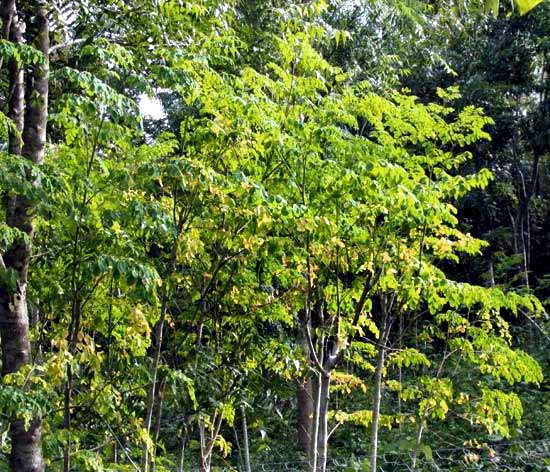
A closer look, however, shows that the produce exceptionally large leaves that are thrice-pinnately compound -- with leaflets divided into leaflets that themselves are divided into leaflets -- as seen below:

Several tree species in our area producing 3-pinnate leaves might be confused with Moringa, but notice that each of the Moringa leaf's ultimate leaflets is borne on a short, slender stalk, or petiolule. Most leaflets on 3-pinnate leaves are not so conspicuously stalked. Also, note the leaflets' rounded tips, not at all sharply pointed as with most other such leaflets.
The other day Lee at Genesis in Ek Balam requested some Moringa branch tips so she could harvest the thumbnail-size leaflets to mix into a super-charged omelet. When I presented her with a green bouquet of branch tips she put them into a container filled with water, as shown below:
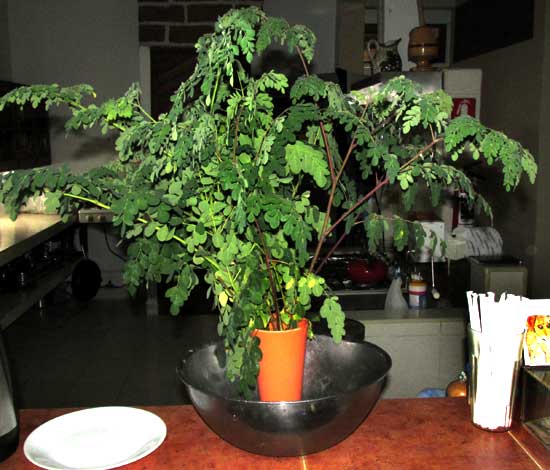
The idea behind the composition shown in the above picture is to have the leaflets fall off without those stiff little petiolules being on them to get stuck in teeth. Lee says that after putting the bouquet in a corner for a few days the leaflets fall off, leaving the petiolules behind. She thinks the water in the vase somehow may be necessary.
I've laboriously removed a couple of cupfuls of Moringa leaflets for my own omelets. I couldn't see that they contributed much or any taste, though I liked knowing that they were so nutritious. If you taste raw Moringa leaflets right off the tree, you can taste oxalic acid, as if you were nibbling on sorrel or oxalis leaves. Oxalic acid is produced by many plants to immobilize excess calcium in their systems, so I worry about Moringa's heavy calcium load -- 125% of the body's daily Calcium need, according to our list above -- and all that calcium might lead to kidney stones.
With the experience I've had so far, I much prefer Chaya leaves to those of Moringa, and we have a lot of Chaya here. And Chaya leaves don't come with those pesky little petiolules.
from the February 5, 2017 Newsletter issued from Rancho Regenesis in the woods ±4kms west of Ek Balam Ruins; elevation ~40m (~130 ft), N20.876°, W88.170°; north-central Yucatán, MÉXICO
MORINGA TREE ROOT FOR HORSERADISH
I'd read that one of several names for the Moringa is Horseradish Tree, and I love horseradish, so I've been eager to explore Moringa's horseradish aspect. However, the part producing horseradish-like tissue is its roots, and I didn't want to damage our trees by digging out their roots. This week a burro reached through a fence and chomped a young Moringa in two, eating the top part, so I figured it would be OK to pull up the rest, with the horseradishy roots. Below, you can see the root, cut in two to display its white, succulent interior:
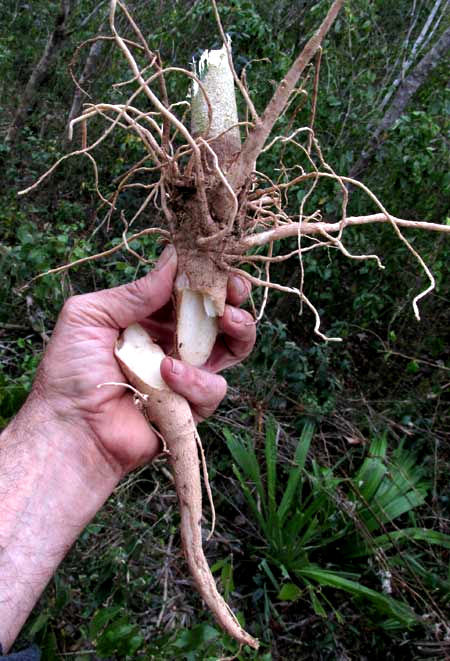
In the picture, the part above my thumb tip was too woody to eat, but below the thumb the tissue was of the consistency of a fresh carrot. It would snap if you bent it too much. And it did indeed smell just like horseradish.
The next morning I grated the lower part of the root into my breakfast stew, and the stew ended up tasting just as if I'd seasoned it with horseradish. So, there you go: Moringa root really can provide a delicious horseradish taste to your meals.
from the March 5, 2017 Newsletter issued from Rancho Regenesis in the woods ±4kms west of Ek Balam Ruins; elevation ~40m (~130 ft), N20.876°, W88.170°; north-central Yucatán, MÉXICO
MORINGA FLOWERING
I've been eager for our Moringas to flower because my old Bailey's Manual of Cultivated Plants places the Moringa Family, the Moringaceae, near the Mustard Family, the Brassicaceae. We think of members of the Mustard Family as tender herbs, but these Moringas form substantial trees, so I've wondered if Moringa flowers look anything like mustard flowers.
Below, you can see a panicle-type cluster of Moringa flowers:
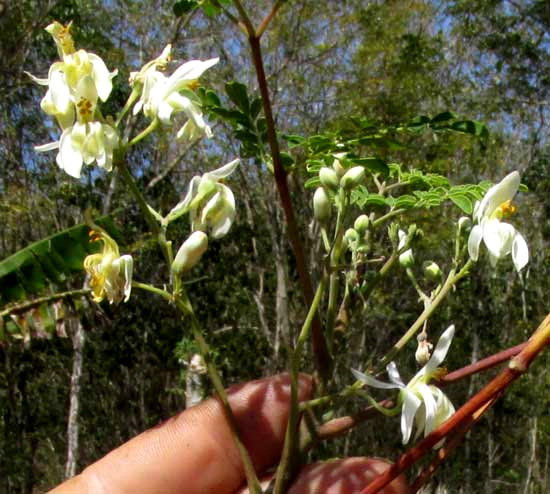
Flowers in the Mustard Family often are arranged in panicles. Now look at an individual Moringa flower,
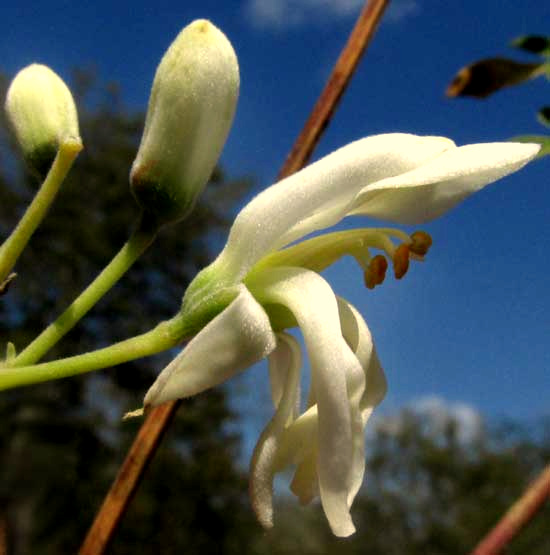
Mustard family flowers are symmetrical, but these Moringa flowers are strongly bilaterally symmetrical -- one side being a mirror image of the other. Mustard flowers normally bear four sepals and four petals, but Moringa flowers exhibit five sepals and five petals. Mustard blossoms usually produce six stamens, of which four are longer than the other two, but our Moringa flower bears five functional stamens of different lengths. Below, a Moringa flower is shown from the front:
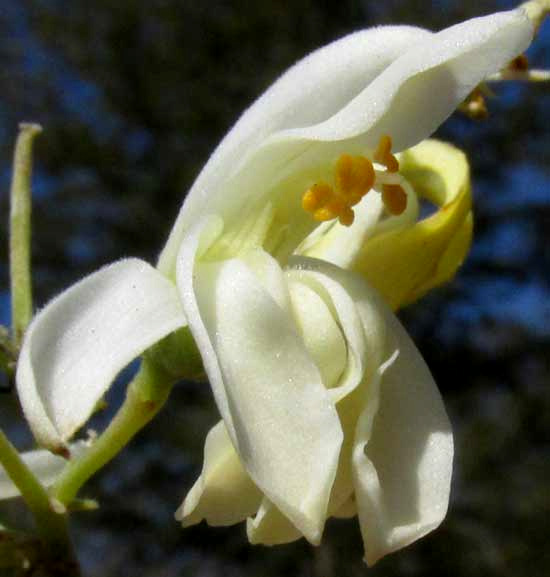
Below, a Moringa flower whose petals have fallen off displays its stamens, style and stigma:

The brown items at the upper, right are pollen-producing anthers, with two anthers having fallen off their filaments. The slender, pointed item extending beyond the outermost anther is the style, the pointed tip of which is the stigma.
So, a Moringa flower is considerably different from a Mustard Family flower. However, my old manual indicates that Moringa fruits look a good bit like Mustard Family fruits, so now I'm waiting for our Moringas' fruits, which I hope to show to you later...
from the June 25, 2017 Newsletter issued from Rancho Regenesis in the woods ±4kms west of Ek Balam Ruins; elevation ~40m (~130 ft), N20.876°, W88.170°; north-central Yucatán, MÉXICO
MORINGA FRUITS
Above, I say that my old Bailey's Manual of Cultivated Plants places the Moringa Family, the Moringaceae, near the Mustard Family, the Brassicaceae. However, we saw that Moringa flowers don't look much like Mustard Family flowers, so we wondered whether the fruits might show more relationship with that family.
Now I can show you some Moringa fruits, below:
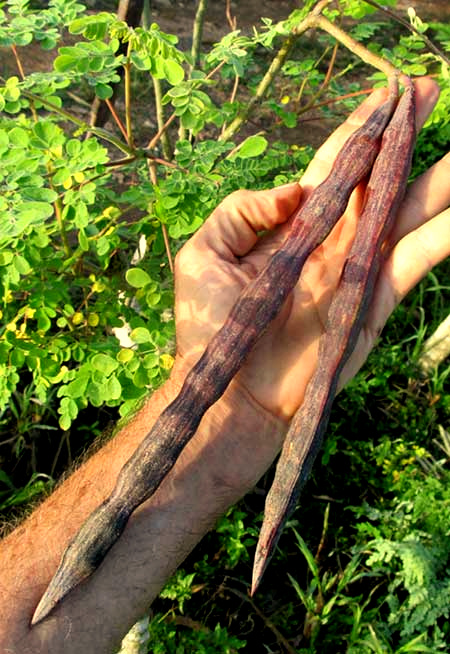
And they are indeed structured very much like a Mustard Family fruit, only they're much larger than any mustard fruit I've ever seen. Breaking open a pod, the seeds could as well be gigantic mustard seeds, shown below:

Both the Mustard and Moringa Families produce capsular fruits that break open, or "dehisce," for their entire lengths. One difference is that that the Mustard Family's fruits break into two sides, while the Moringa's capsules dehisce into three faces.